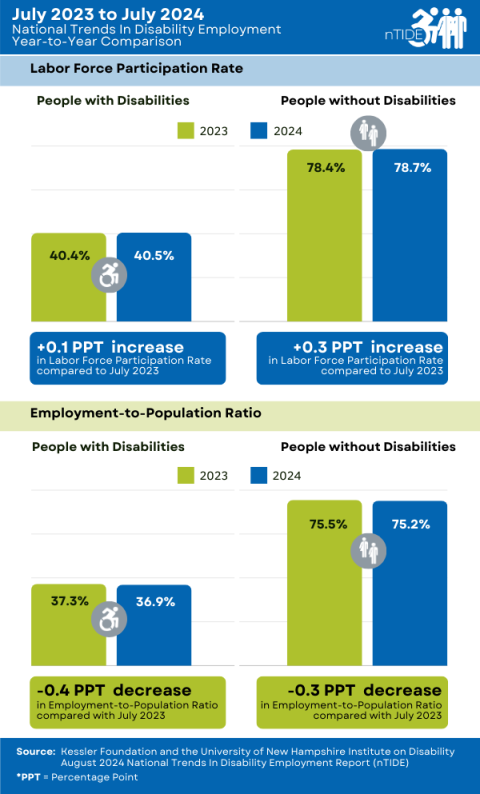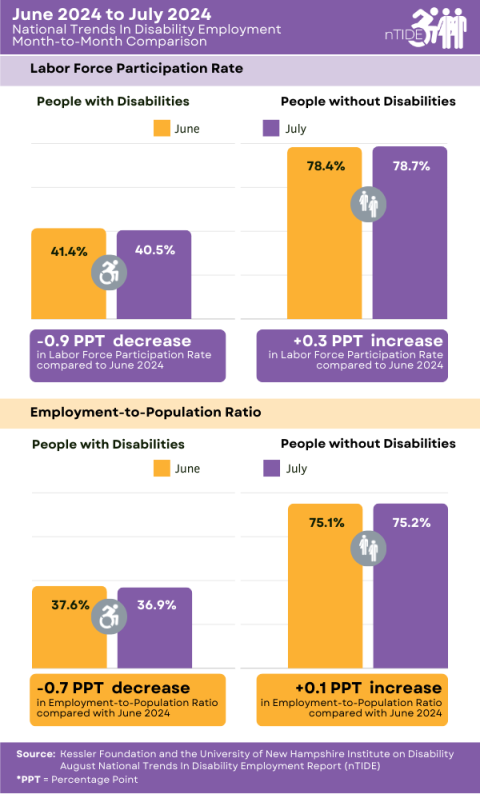
Join us for the next nTIDE Lunch & Learn Webinar featuring guest presenter Charlotte Dales of Inclusively.
nTIDE July 2024 Jobs Report: People with Disabilities Hold Steady in Labor Market Despite Federal Reserve's Attempts to Slow Economy
National Trends in Disability Employment (nTIDE) – Issued semi-monthly by Kessler Foundation and the University of New Hampshire
August 2, 2024 – Following significant gains since the post-pandemic lockdown, employment rates for people with disabilities have plateaued, remaining near historic high levels over the past year despite the Federal Reserve’s efforts to slow the economy, according to today’s National Trends in Disability Employment – semi-monthly update (nTIDE) issued by Kessler Foundation and the University of New Hampshire’s Institute on Disability (UNH-IOD).
Year-to-Year nTIDE Numbers (comparing July 2023 to July 2024)

The employment-to-population ratio for people with disabilities (ages 16-64) decreased from 37.3 percent in July 2023 to 36.9 percent in July 2024. The employment-to-population ratio for people without disabilities also decreased slightly.
Based on data from the U.S. Bureau of Labor Statistics (BLS) Jobs Report released today, the employment-to-population ratio for people with disabilities (ages 16-64) decreased from 37.3 percent in July 2023 to 36.9 percent in July 2024 (down 1.1 percent or 0.4 percentage points). The employment-to-population ratio for people without disabilities (ages 16-64) also decreased from 75.5 percent in July 2023 to 75.2 percent in July 2024 (down 0.4 percent or 0.3 percentage points).
“The employment-to-population ratio for people with disabilities has leveled off over the past year. This is contrary to what we saw after the COVID pandemic lockdown when the employment-to-population ratio showed month-over-month increases for two years,” remarked John O’Neill, PhD, director of the Center for Employment and Disability Research at Kessler Foundation. “This may be an indication of the soft-landing that the Federal Reserve was hoping to achieve without sending the economy into recession,” he added.
Meanwhile, the labor force participation rate for people with disabilities (ages 16-64) increased from 40.4 percent in July 2023 to 40.5 percent in July 2024 (up 0.2 percent or 0.1 percentage points). For people without disabilities (ages 16-64), the labor force participation rate also increased from 78.4 percent in July 2023 to 78.7 percent in July 2024 (up 0.4 percent or 0.3 percentage points).
“Overall, people with disabilities are engaged in the labor market at historic levels. The labor force participation rate has ratcheted around 40.8 percent over the past 12 months,” said Andrew Houtenville, PhD, professor of economics and research director of the UNH-IOD. “This trend might indicate increased employment opportunities due to labor shortages across many parts of the country, although it could also be driven by individuals needing to support themselves and their families amid rising living costs,” he added.
Month-to-Month nTIDE Numbers (comparing June 2024 to July 2024)

The employment-to-population ratio for people with disabilities decreased from 37.6 percent in June 2024 to 36.9 percent in July 2024; for people without disabilities the ratio stayed almost even. The labor force participation rate for people with disabilities decreased while people without disabilities rate increased slightly.
The employment-to-population ratio for people with disabilities (ages 16-64) decreased from 37.6 percent in June 2024 to 36.9 percent in July 2024 (down 1.9 percent or 0.7 percentage points). For people without disabilities (ages 16-64), the employment-to-population ratio increased from 75.1 percent in June 2024 to 75.2 percent in July 2024 (up 0.1 percent or 0.1 percentage points).
The labor force participation rate for people with disabilities (ages 16-64) decreased from 41.4 percent in June 2024 to 40.5 percent in July 2024 (down 2.2 percent or 0.9 percentage points). For people without disabilities (ages 16-64), the labor force participation rate increased from 78.4 percent in June 2024 to 78.7 percent in July 2024 (up 0.4 percent or 0.3 percentage points).
In July, among workers ages 16-64, the 6,081,000 workers with disabilities represented 4.0 percent of the total 150,814,000 workers in the U.S.
Ask Questions about Disability and Employment
Each nTIDE release is followed by an nTIDE Lunch & Learn online webinar. This live broadcast, hosted via Zoom Webinar, offers attendees Q&A on the latest nTIDE findings, provides news, updates from the field, and features invited panelists who discuss current disability-related findings and events.
On August 2, 2024, at 12:00 pm – 1:00 pm Eastern, guest presenter Charlotte Dales of Inclusively, join Drs. O’Neill and Houtenville. Join our free Lunch & Learn live or visit the nTIDE archives at: ResearchonDisability.org/nTIDE. Also, register now for our mid-month nTIDE Deeper Dive into employment trends at nTIDE Deeper Dive – 08/23/2024.
